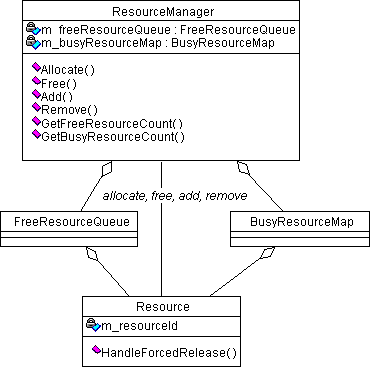Resource Manager Design Pattern
In Embedded and Realtime Systems, there occur many instances of Resource management. Most commonly used design pattern to manage resources of a specific type is the Resource Manager Pattern. This pattern is described using a standard pattern definition template.
This design pattern implementation uses STL (Standard Template Library), so please review STL Design Patterns.
Intent
The main intention here is to manage multiple resources of the same type. To maintain the status of managed resources, a resource manager is implemented that maintains two lists of resources. Free list contains all the resources that are free. Busy list contains all the resources that are busy. A resource allocation request is serviced by the resource manager by allocating a resource from the free list and putting it in the busy list. Similarly, a resource release request is serviced by the resource manager by inserting the freed resource to the free list.
Also Known As
- Resource Allocator
- Resource Pool
Motivation
The resource manager design pattern implements a centralized management strategy for resource usage. Looking at the free and busy lists of resources gives a clear picture of the current resource usage in the system. Using the resource manager, the application can quickly figure out all allocated resources in the system. This information helps in implementing audits.
Applicability
The resource manager design pattern finds applicability in situations where centralized management of multiple resources of same type is involved.
Structure
The resource manager keeps two lists, one for busy resources and one for free resources. Internally the free list may be maintained as a stack if hottest resource first type of scenario needs to be implemented. If a coldest resource first type of scenario is to be implemented, the free list may be maintained as a queue. The busy list is maintained as a STL map so that resources can be quickly accessed. (The map is keyed with the resource-id, a unique number assigned to every resource).
Participants
The key actors of this design pattern:
- Resource Manager: Manages all free and busy resources using the free queue and busy map.
- Free Resource Queue: Keeps track of free resources in a STL queue.
- Busy Resource Map: Manages the busy resources in a STL map.
- Resource: Defines a resource object with its own resource-id.
Collaboration
The following diagram shows the relationship and collaboration between various classes involved in the Resource Manager Pattern. Points to note are:
- Resource Manager contains the Free Resource Queue and the Busy Resource Map
- Free Resource Queue and Busy Resource Map contain Resource objects
- Resources are directly allocated from the Resource Manager. The user of the class is not aware of its internal structure as a free and busy lists.

Consequences
When Resource Manager Pattern is used, the programmer always has access to all the resources. Thus any action on resources can be initiated from the Resource Manager, instead of handling it separately in all objects that allocate resources.
Implementation
The following scenarios are supported by the Resource Manager:
Allocating a Resource
- A system entity sends a request for a resource to resource manager.
- The resource manager allocates a resource from the FreeResourceQueue.
- The resource manager removes the resource from the FreeResourceQueue.
- The resource manager adds the resource to the BusyResourceMap.
- The resource manager responds to system entity with the pointer of the allocated resource.
Freeing a Resource
- A system entity sends a resource release request to the resource manager.
- The resource manager removes the resource from the BusyResourceMap.
- The resource manager adds the resource to the FreeResourceQueue.
Adding a Resource
- When a resource is created, it is added to the FreeResourceQueue.
Removing a Resource
- Check if the resource is present in the BusyResourceMap.
- If the resource is present, inform resource about the forced release (if the resource is currently in use, the application using the resource needs to be notified)
- Remove the resource from the BusyResourceMap.
- If the resource is not present in the BusyResourceMap, remove the resource from the FreeResourceQueue.
Sample Code and Usage
Here is the code for a typical implementation of this pattern using STL:
Resource Manager
Known Uses
Any application where resources need to be managed. A few examples of a Resource Manager use are:
- Timeslot Manager
- Orbit Manager
- Terminal Manager